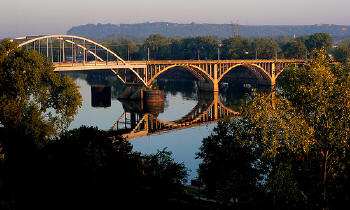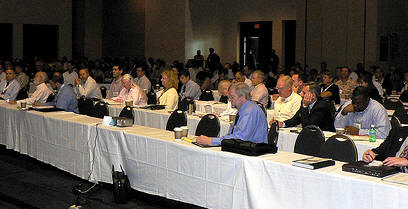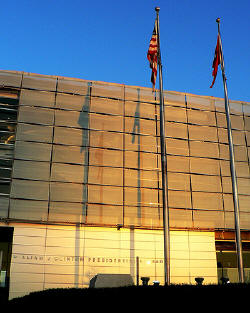 |
States/State Coordinators are on the map. It is tough to measure attitude changes, but my sense is that the tension between state GIS bodies and local and federal players seems to be far lower than when I first attended a NSGIC meeting in 2002. Some anecdotal evidence:
- In DC, when a District police group got a grant and was told to contact DC's coordinating office, it did.
- When an ESRI rep had the chance to meet with the governor of Arkansas and noted she was involved in GIS, Mr. Huckabee said, "Oh, you must know Shelby [Johnson, GIO]."
 |
"Imagery for the Nation" matters. While there are still many questions about exactly how this initiative will play out, including the roles of public and private sector players, there's a lot of energy aimed at making it happen. Vendors and public sector attendees were weighing "how they could help."
 |
GLOB is confusing. The work exploring a potential geospatial line of business (GLOB) is confusing to many. Exactly how the data collection by the Office of Management and Budget is being carried out, if the data collected will be made available to the public, and how such a line of business, if enacted, will impact federal and other agencies is unclear. I hope to gather and share more about how we got to this point and what a change to a line of business may mean in the coming months.
NSGIC-ers are Web savvy. While there are no requirements that state coordinators be techies, they are information sharers, so perhaps it's not surprising that the majority read blogs and many tap into RSS feeds and use wikis. There were several questions about GeoRSS. (GeoRSS release 1.0 is available from GeoRSS.org; it is not an OGC or W3C standard at this time.)
Private players lighten the load. Several coordinators stated they'd made their imagery available to Google or Microsoft for use in their portals. The logic from one state could be summed up this way (I paraphrase): "If I can have those who want to find their house or 'play' hit on someone else's server not contact me for support, and get what they need, it frees our resources (hardware, bandwidth, people) for more analytical work." Another bonus: the link or copyright shown on the imagery is good PR for state GIS programs and coordinators who enabled the data collection and/or sharing.
Legal issues abound. A question about whether the census could provide point locations of addresses got a resounding "no," as it is a privacy matter. One presenter was told by organization lawyers not to speak to some issues. One state can't possibly put up or use blogs or listen to podcasts because the IT folks won't allow it. I hate to say it, but all of us are going to have to pay more attention to legal issues than we'd probably like in the coming months and years.
What I didn't hear. I don't want to draw any conclusions from this short list, but in looking back I was surprised that I didn't hear much, if anything, about: 3D, open source, CAD integration and mashups. Granted NSGIC is not so much a technology event as it is a policy/procedures/idea sharing event. Still, these are hot topics in our industry that I expected might come up.
I continue to be impressed by the energy I see at the NSGIC meeting. It's an energy borne not so much from "cool technology" but from what can be done across a state, and thus a nation, with technology, vision, hard work and collaboration. If you want to learn more about how to "get things done with geospatial," these people can show you the way.